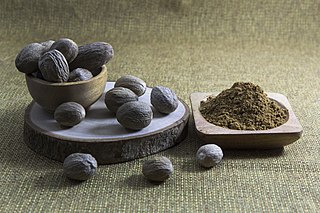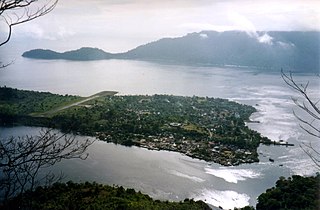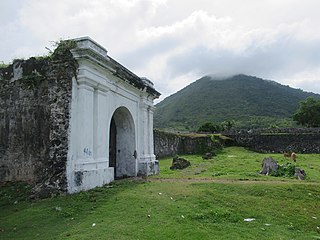
The Banda Islands are a volcanic group of ten small volcanic islands in the Banda Sea, about 140 km (87 mi) south of Seram Island and about 2,000 km (1,243 mi) east of Java, and constitute an administrative district (kecamatan) within the Central Maluku Regency in the Indonesian province of Maluku. The islands rise out of 4-to-6-kilometre deep ocean and have a total land area of approximately 172 square kilometres (66 sq mi). They had a population of 18,544 at the 2010 Census and 20,924 at the 2020 Census. Until the mid-19th century the Banda Islands were the world's only source of the spices nutmeg and mace, produced from the nutmeg tree. The islands are also popular destinations for scuba diving and snorkeling. The main town and administrative centre is Banda Neira, located on the island of the same name.

Nutmeg is the seed, or the ground spice derived from that seed, of several tree species of the genus Myristica; fragrant nutmeg or true nutmeg is a dark-leaved evergreen tree cultivated for two spices derived from its fruit: nutmeg, from its seed, and mace, from the seed covering. It is also a commercial source of nutmeg essential oil and nutmeg butter. Indonesia is the main producer of nutmeg and mace, and the true nutmeg tree is native to its islands.

The United East India Company was a chartered company established on 20 March 1602 by the States General of the Netherlands amalgamating existing companies into the first joint-stock company in the world, granting it a 21-year monopoly to carry out trade activities in Asia. Shares in the company could be bought by any resident of the United Provinces and then subsequently bought and sold in open-air secondary markets. It is sometimes considered to have been the first multinational corporation. It was a powerful company, possessing quasi-governmental powers, including the ability to wage war, imprison and execute convicts, negotiate treaties, strike its own coins, and establish colonies.

Jan Pieterszoon Coen was an officer of the Dutch East India Company (VOC) in the early 17th century, holding two terms as governor-general of the Dutch East Indies. He was the founder of Batavia, capital of the Dutch East Indies. Renowned for providing the impulse that set the VOC on the path to dominance in the Dutch East Indies, he was long considered a national hero in the Netherlands. Since the 19th century, his legacy has become controversial due to the brutal violence he employed in order to secure a trade monopoly on nutmeg, mace and clove. During the last stage of the Dutch conquest of the Banda Islands, Coen depopulated the islands to such a degree that of around 15,000 original residents, only 1,000 remained by the end, with the rest dead, exiled, or taken as slaves.

The Dutch colonial empire comprised the overseas territories and trading posts controlled and administered by Dutch chartered companies—mainly the Dutch East India Company and the Dutch West India Company—and subsequently by the Dutch Republic (1581–1795), and by the modern Kingdom of the Netherlands after 1815. It was initially a trade-based system which derived most of its influence from merchant enterprise and from Dutch control of international maritime shipping routes through strategically placed outposts, rather than from expansive territorial ventures. The Dutch were among the earliest empire-builders of Europe, following Spain and Portugal and one of the wealthiest nations of that time.

Run is one of the smallest islands of the Banda Islands, which are a part of the Moluccas, Indonesia. It is located within Banda District (kecamatan) in Central Maluku Regency.

Banda Api is an island in the Banda Islands, Indonesia. It is administered as part of the administrative district (kecamatan) within the Central Maluku Regency in the province of Maluku.

Company rule in the Dutch East Indies began when the Dutch East India Company appointed the first governor-general of the Dutch East Indies in 1610, and ended in 1800 when the bankrupt company was dissolved and its possessions were nationalized as the Dutch East Indies. By then it exerted territorial control over much of the archipelago, most notably on Java.

Pieter van den Broecke was a Dutch cloth merchant in the service of the Dutch East India Company (VOC), and one of the first Dutchmen to taste coffee. He also went to Angola three times. He was one of the first Europeans to describe societies in West and Central Africa and in detail trade strategies along the African coast.

Banda Neira is an island in the Banda Islands, Indonesia. It is administered as part of the administrative Banda Islands District within the Central Maluku Regency in the province of Maluku. To the south is the main town of the same name, which is the largest town in the archipelago with around 7,000 inhabitants.

Fort Belgica is a 17th-century fort in Banda Neira, Banda Islands, Maluku Islands, Indonesia; administratively in Central Maluku Regency, Maluku. The fort acted as a fortification system for the islands of Banda which was the only place in the world during that period where nutmeg was produced.

Fort Tolukko is a small fortification on the east coast of Ternate facing Halmahera. It was one of the colonial forts built to control the trade in clove spices, which prior to the eighteenth century were only found in the Maluku Islands. It has been variously occupied by the Portuguese, the native Ternate Sultanate, the Dutch, the British and the Spanish. It was abandoned as a fort in 1864, renovated in 1996, and is now a tourist attraction.

Ambon was a governorate of the Dutch East India Company, consisting of Ambon Island and ten neighbouring islands. Steven van der Hagen captured Fort Victoria on 22 February 1605 from the Portuguese in the name of the Dutch East India Company. Until 1619, Ambon served as the capital of the Dutch possessions in East Asia. In that year Batavia was founded to function as the staple port for the Dutch East India Company in Asia. The island was the world center of clove production until the 19th century. The Dutch prohibited the rearing of the clove-tree in all the other islands subject to their rule, in order to secure the monopoly to Ambon.

Fort Nassau was the first Dutch fort built on Banda Neira Island, the main island of the Banda Islands, part of Maluku in Indonesia, completed in 1609. Its purpose was to control the trade in nutmeg, which at that time was only grown in the Banda Islands.

Fort Kastela is a ruined Portuguese fortress located at the southwest coast of Ternate. It is famous for being the first colonial fortification constructed in the Spice Islands (Maluku) of Indonesia. Built by the Portuguese in 1522, it is also referred to in different languages as São João Baptista de Ternate or Fortaleza de Ternate (Portuguese), Ciudad del Rosario (Spanish) or Gammalamma. Today it is locally known as Kastella/Kastela.

Banda Besar, historically also known as Lonthoir, is the largest of the Banda Islands in Indonesia. It is administered as part of Banda District, Central Maluku Regency, Maluku Province.

The Dutch conquest of the Banda Islands was a process of military conquest from 1609 to 1621 by the Dutch East India Company of the Banda Islands. The Dutch, having enforced a monopoly on the highly lucrative nutmeg production from the islands, were impatient with Bandanese resistance to Dutch demands that the Bandanese sell only to them. Negotiations collapsed after Bandanese village elders deceived and murdered the Dutch representative Pieter Willemsz. Verhoeff. Under the command of Jan Pieterszoon Coen the Dutch resorted to a forcible conquest of the islands, which became severely depopulated as a result of Coen’s massacres, forced deportations, and the resulting starvation and disease.
Southeast Asia is extensive in diversity, from its cultural geography to its borders that lay the foundation to its physical geography and cultural diversity. Early 16th century Southeast Asia countries faced the sedimentation of states and were propelled towards modern day civilization. This formation began through Southeast Asian contact with foreign groups and the adaptation and integration of such culture into the demographics and geography of Southeast Asia. Post-1500 Southeast Asia Archaeology, is often referred to as the archaeology of colonization as it focuses on the period of European colonization in Southeast Asia. Archeology of colonization thus is the analysis of trade ports, colonial and indigenous communities, and the study of historic and cultural patterns. Additionally, archaeology of colonization hopes to gain a deeper understanding of the history and culture of indigenous communities in particular, because history is often told and influenced by the more powerful groups, which is in this case, colonizers.
This is a timeline of the 17th century.

The invasion of the Spice Islands was a military invasion by British forces that took place between February and August 1810 on and around the Dutch owned Maluku Islands also known as the Spice Islands in the Dutch East Indies during the Napoleonic wars.





















